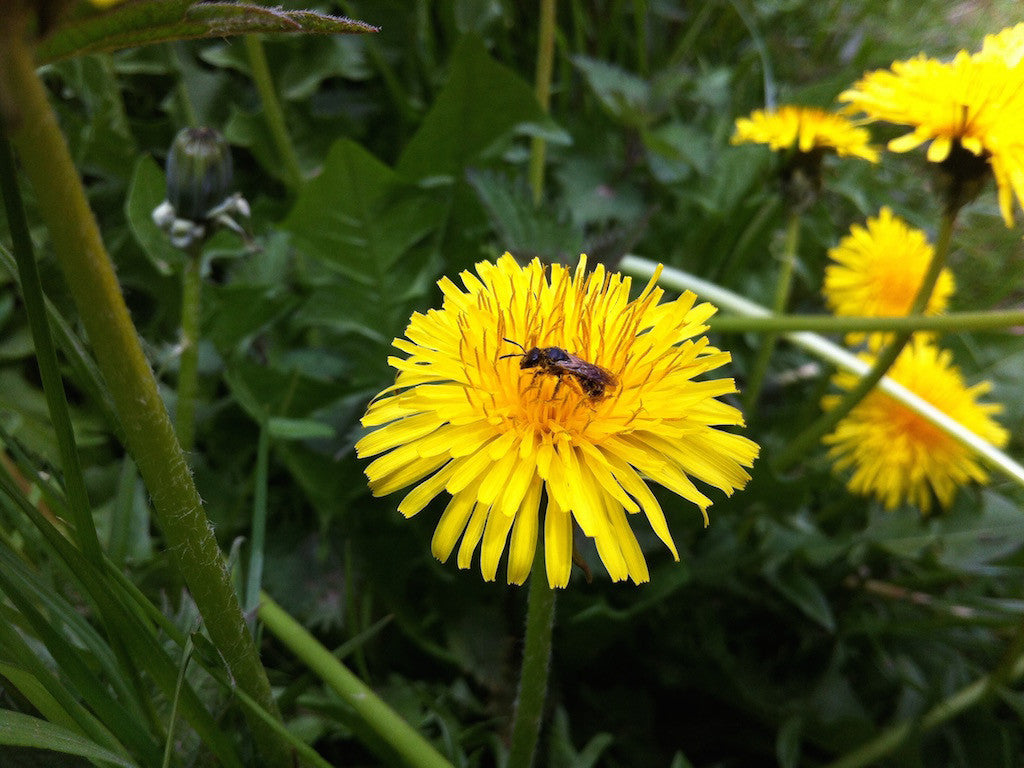
Creating a Buzz in the Garden
A solitary bee on a dandelion.
This Easter weekend, despite the reassuringly British forecast of showers and sunny spells, many of us are eager to get out into the garden. It’s a great opportunity to think about how to make your patch a haven, not only for yourself, but for pollinators too. Having more bees in your garden could improve your veg patch harvest and the buzz of bees meandering around the borders is a joy to hear, in the words of the Bumblebee Conservation Trust, go on, “save the sound of summer”.
Of course we’re particularly keen on honeybees, but don’t forget the other bees – the UK has 26 species of bumblebee and about 270 other bee species. Most of the bees are solitary, one female bee going it alone, building her own nest and foraging to feed her eggs, rather than living in a social colony with a queen and workers, like honeybees and bumblebees. I’m focusing here on bees, but other insects also pollinate flowers by feeding on them, so that they can turn into fruit and vegetables and seeds; butterflies, moths, beetles, wasps and flies are important pollinators.
The bees need a helping hand; some wild bumblebees have declined significantly, with three species already having become extinct in the UK. Butterflies and moths are also declining dramatically. Why? The countryside has fewer flowers than it once did; hay meadows have been ploughed up in the last century and herbicides have reduced the pesky weeds (i.e. wildflowers), which were once a nectar source.
There is a growing body of evidence to confirm what we already knew at the London Honey Company, that some bees are thriving in suburbia compared to the countryside and it’s not just the honeybees: the buff-tailed and common carder bumblebees have higher populations in the suburbs compared with down the farm. People’s gardens can provide a lot more food for bees than hedge–to-hedge fields of grain.
What can you do? If you have a garden then here are our tips on how to make it a bee haven:
- Plant bee-friendly plants. Great flowers for bee food include borage (it makes a wonderful clear honey), phacelia, comfrey, marjoram and thyme. Most herbs are good nectar sources, so even if you only have a windowsill then put out some pots of herbs. Crocus is a great online plant retailer we use, with a bee-friendly section.



Herbs are perfect for pollinators and useful for the kitchen, photos from Crocus online plant shop.
- Try to always have something flowering for them all year round (March till August).
- Variety is the spice of life: provide lots of different shapes of flowers and you’ll cater for a wider variety of bees, as each species has a different length tongue and so can feed from different sized flowers – imagine trying to lick a plate (a shallow flower) compared to sticking your tongue into a tall glass (deep flowers). Our rarest bumblebees have long tongues and like deep flowers such as foxgloves, delphiniums and aquilegia.
- Let areas of the lawn grow longer to allow the dandellions in the grass to flower, they are a shallow flower much loved by many bees and hoverflies. If you cut a path through the area of long grass it makes it look purposeful and sculpted.
- Avoid showy annual bedding plants, double petal varieties make it difficult for bees to get to the nectar.
 As well as food, bees need a home. Bumblebee boxes you buy rarely work, but solitary bee hotels are easy to make from bundles of bamboo canes and blocks of wood with holes drilled in (6mm to 10mm), once attached to a tree or wall at chest height facing the sun they are a delight to watch as they become occupied!
As well as food, bees need a home. Bumblebee boxes you buy rarely work, but solitary bee hotels are easy to make from bundles of bamboo canes and blocks of wood with holes drilled in (6mm to 10mm), once attached to a tree or wall at chest height facing the sun they are a delight to watch as they become occupied!- Be careful of what you put on your garden, avoid using sprays to counter insecticides damaging your veg, many applications available in the shops contain harmful insecticides which are not bee-friendly. Instead try alternative organic methods.
Happy Easter weekend! Enjoy the buzz in your garden.
If you'd like to read more on other bees, we recommend:
A Field Guide to Bees of Britain and Ireland by Steven Falks
A Sting in the Tale by Dave Goulson
This post has drawn on an article by Dave Goulson in the the March edition of the Beekeepers Quarterly.
